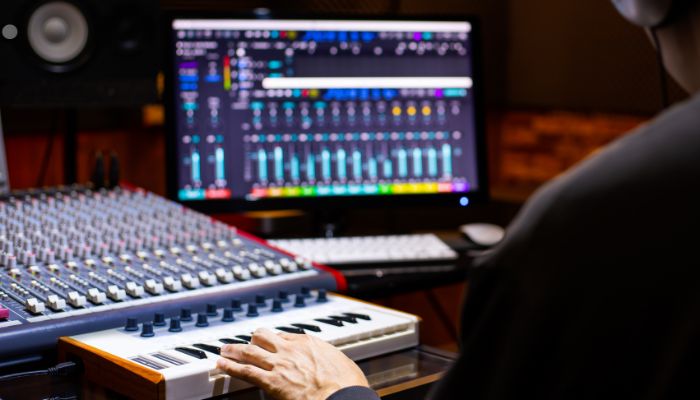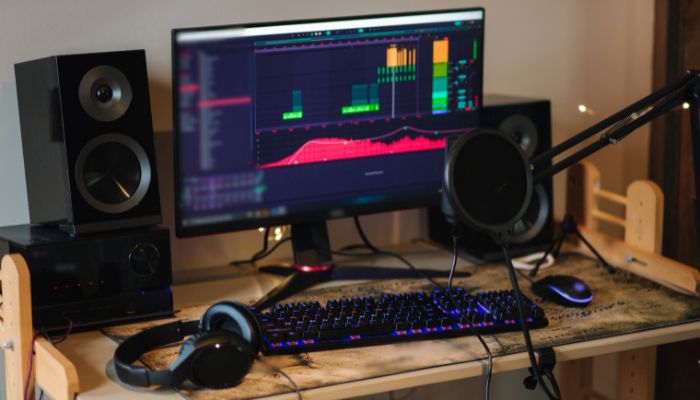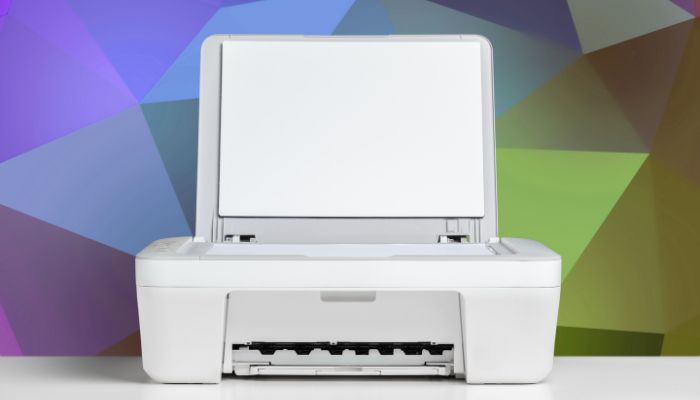Music production software or DAWs (digital audio workstations) used to be extremely limited and primitive.
Today, music production software is sophisticated with slick interfaces, insane cutting-edge functionality and tons of awesome software instruments, synths, samples and plugins.
Musicians and producers can now access a stunningly diverse sonic palette and powerful audio editing tools directly from their PC or laptop.
From recording to editing, mixing, mastering, sound design and much more; music production software does it all, and it’s comparatively cheap compared to a studio full of instruments, recording hardware and analogue gear!
The various DAWs available right now all have a similar goal in mind; the capture and manipulation of audio for many purposes.
But, there’s a lot of variety there and choosing the right software for you can be tricky.
Here, we’re going to discuss Pro Tools, Ableton, Logic Pro, Reaper, Studio One and FL Studio.
Production ‘In the Box’
Music production is no longer confined to the walls of an expensive studio.
Now, music producers around the world can produce music anywhere. Your bedroom, basement, garage, hotel room, grandma’s house, girlfriend’s house…wherever you go, you can take your production software with you.
Even top engineers produce hit records entirely ‘in the box’ – hit Grammy-winning albums like Billie Elish’s When We Sleep, Where Do We Go? were produced in bedroom studios!
What Else Do You Need To Produce Music?
Software is the first port-of-call and is essential for any and all music production.
With music-making software, you can produce music pretty much instantly using headphones or standard speakers.
But, to get the most out of your production rig, other investments are necessary.
Namely, you’ll likely need an audio interface and some monitor speakers. Monitor speakers are much, much better than headphones as headphones do not provide a particularly accurate representation of your music’s stereo image and dynamics.
Even then, there is a solution. Plugins such Waves’ NX replicate the sound of a real recording studio from within your headphones!
1. FL Studio
- Best For: Electronic music production
- Compatibility: Windows and Mac OS
- Latest Version: FL Studio 20
Paid/Trial: There are different priced packages available, from the entry-level “fruity” edition to the all plugins edition. It’s a one time payment software with various pricing options, starting around £76 at the low end, all the way up to over £300 at the high end. We recommend the “producer Edition” package which is available on Amazon at a great price.
Headlines
- Decent free trial (as long as you don’t quit the program!)
- Low cost for entry-level packages
- Intuitive pattern maker for beat making
- Plethora of reasonably priced plugins available (or included in the more expensive bundles)
- Crisp interface with excellent arrangement view
Interface
Fruity Loops has been around for almost 20 years and it was amongst the first DAWs to really try and innovate the production process using its famous modular drag-and-drop pattern cell sequencer.
FL Studio’s interface is familiar and funky. It has either separate or combined views for arrangement and mixing. The arrangement view is superb and it really suits electronic music production and beatmaking where lots of repeated patterns need to be arranged and layered.
The channel rack is also great, allowing users to quickly access software instruments and plugins for routing to sends, etc.
It’s also very easy to create time signature changes throughout the arrangement, these will automatically change the time signature of beats programmed with its pattern cell sequencer, which is pretty cool.
Features
FL Studio’s headline feature has always been its pattern cell sequencer. It’s super-easy to build-up complex loops from software instruments and samples. These can then be copied into the arrangement rapidly.
There are plenty of professional cutting-edge utility features too, including the ability to freeze tracks and render the audio to free up the CPU.
Whilst FL Studio is not ideally suited to advanced studio recording, it does the job and has a decent plug-in delay compensation engine to improve its usability as recording software.
In terms of plugins, there are tons included for free including some real gems such as the veteran Sytrus and surprisingly effective Edison. However, most of these will not come with FL Studio’s two cheapest versions. If you want the full FL experience, you’ll have to fork out around £370 for the All Plugins version.
Summary: FL Studio
FL Studio is awesome for electronic music producers and beatmakers. For recording, it’ll do the basics well but it isn’t a natural in this department. It’s best for those who want to make electronic music right out of the box using its innovative pattern builder. And the instrument pack has some superb pads, samples, and FM synths.
2. Ableton Live
- Best For: All-rounder, live performance. Favoured for techno music production.
- Compatibility: Windows and Mac OSX
- Latest Version: Ableton Live 10 (11 due to come out in 2021)
Paid/Trial: Ableton offers a 30-day free trial for its top-tier Suite package (currently extended to 90 days). Then, there are 3 tiers including Intro, which is just £55 and limits you to 16 tracks and the full Live 10 Standard (£255) and Live 10 Suite (£431) versions. If you want Ableton’s live performance features, you’ll need the Suite (£431).
Headlines
- Suitable for recording, live performance and ‘in the box’ production
- Some awesome plugins coded with Cytomic
- Max for Live and Session View mode for live performance
- Top-grade software instruments like Wavetable
- Powerful interface and great for producing techno.
DAW Interface
With buttons, switches and tabs galore, Ableton’s interface is complex and takes some getting used to.
One of Ableton’s key features is that it has two arrangement views (3 including your mixer view). The first is the standard arrangement view that lets you arrange your studio similarly to any other DAW, editing clips, moving them around and adding automation, etc.
The second arrangement view is the Session View. This essentially ‘converts’ all of your audio and tracks into editable blocks arranged in bars. It converts your standard session into a live remixing or production session, designed for live performance but also for testing different arrangements.
It sounds complicated, and to be honest, it is. Ableton has the steepest learning curve of any DAW but the rewards are great and once you know what all those buttons and switches too, it gets a lot easier.
Features
Ableton’s Session View and Max for Live function which allows you to produce your music and then flip it onto a live session with triggerable sections and live remixing capability is its headline feature.
There are some awesome plugins in Ableton too, including Wavetable, which bears similarities to Serum, an advanced Echo unit and Drum Buss which allows you to route drums and other audio to an all-in-one beat processing unit.
Ableton has a pretty exhaustive feature set and it has to go down as one of the deepest, most comprehensive DAWs ever produced
Summary: Ableton Live
For producers who want to go deep into their performances and provide something off-the-wall and original, Ableton is the one. However, for getting up and running fast with simple products, Ableton has a relatively steep learning curve.
3. Logic Pro X
- Best For: Good All-rounder for various music styles.
- Compatibility: Mac OSX
- Latest Version: Logic Pro X
Paid/Trial: Logic Pro X is simply charging a one-time payment for the full version or a 90-day free trial.
Headlines
- Quick-start mode for quick session creation
- 32GB free samples included
- Simple interface with intuitive controls
- Excellent plugins
- Super-crisp Apple-esque UI (great on small screens)
Interface
Logic Pro X’s interface is similar to GarageBand and you can see why Apple acquired Logic to make it the Mac OS go-to DAW. It has many natural synergies with GarageBand, so if you’ve used that and want to take your production to a new level, then Logic is pretty much waiting for you!
Logic’s interface is brilliant, not overcomplicated and intuitive with its standard Arrangement/Mixer views. It’s very economical and easy to use on smaller screens, e.g. MacBooks.
Logic has a cool quick-start mode that allows you to select a session time upon opening a new session, e.g. for recording, vocal recording, etc.
Loading plugins onto tracks and creating automation is very easy in Logic and it’s hard to get stuck or lost, as can be the case with other DAWs.
Features
Logic X is packed full of pro features and tools for editing audio including sum folders that allow you to pack various takes into one track instead of leaving them on multi-tracks. Automation is well implemented.
As well as its flagship synth Alchemy, Logic Pro X includes an excellent high-end reverb unit called ChromaVerb. The Space Designer is also great, perfect for sprucing up instruments recorded in bedrooms or DIY studios.
The Drum Designer is awesome too and allows you to construct life-like drum beats recorded on top kits by top drummers. Many of these are quite organic and include the same stylistic nuances of the pros they were modelled on.
Summary: Logic X
The perfect pro DAW for those moving from GarageBand. Logic X is decked out as a cost-effective all-in-one solution for a variety of music production purposes. It’s easy to use and has some great plugins including the excellent Drum Designer and ChromeVerb.
4. Pro Tools
- Best For: Sound recording
- Compatibility: Windows and Mac OS
- Latest Version: Pro Tools 12
Paid/Trial: Pro Tools is expensive with its two premium versions running at monthly costs of £25 and £70 respectively. The cheaper one only allows a maximum of 32 channels too, which isn’t great for the money.
The full basic version without subscription is £500, the ultimate version costs a mighty £2100 but comes with 116 plugins. There is a free version called Pro Tools First which has a 16 channel limit and limited plugins.
Headlines
- The recording specialist
- Easy to use with uncomplicated interface
- Pro Tools First free version
- Excellent bundled plugins
- Rock-hard stability
- Lifetime software updates – free
Digital Audio Interface

Pro Tools is the least flashy of the top DAWs. It has a bullet-proof interface with a simple two-window view.
First, you have your Mix window which is very well implemented with your inserts and sends clearly displayed on each track. Then, you have the Arrangement window where you edit and compose your audio. The transport section is straightforward and has intuitive loop controls.
The Smart Tool in Pro Tools is excellent and allows you to edit, cross-fade and draw in automation without switching tools. Waveforms can be easily manipulated and time-stretched for quantization using quality algorithms.
Pro Tools is a quality DAW for editing sound for video – you can load in videos easily for score composition, mixing, post-production, etc.
Features
Pro Tools comes with many superb instruments and plugins that include XPand!2, an advanced multi-sound workstation and their new flagship instrument, UVI Falcon. There are tons of processing units by AIR ranging from distortion and saturation to vintage filters, chorus, talk boxes and much more.
It’s worth mentioning that the vast majority of good plugins are available on the first premium tier, which costs £500 for a full lifetime licence. It’s still a lot of money but Pro Tools arguably contains the biggest and best tools out of any DAW for the widest array of music production tasks.
Summary: Pro Tools
Pro Tools is the top dog in recording studios around the world. It is designed primarily for audio recording and everything you’ll need for genuine studio production, so it’s less naturally angled towards electronic music.
It does seem expensive and Avid does have a bit of a reputation in this department, but it’s the price you pay for a thoroughly dependable DAW.
5. Studio One
- Best For: All music genres
- Compatibility: Windows and Mac OS
- Latest Version: Studio One 5
Headlines
- Fully comprehensive DAW with multiple ownership tiers
- Some excellent processing plugins and software instruments
- Bullet-proof design and UI
- Innovative score view
- Show Page live performance mode
- Built-in Audio effects
Paid/Trial: Studio One has 4 different tiers of ownership. The free version is Studio One Prime, which is essentially the full basic program but without 3rd party plugin support, and you only get limited plugins. The Artist package is the cheapest ‘pro’ package and that is reasonably priced at £85.20.
The Professional package is £344.20 and contains pretty much everything in the Studio One and Presonus ecosystem except Notion, a composition plugin, which is only available on Studio One Sphere, which gives you absolutely everything at the cost of £13.47 a month, which isn’t too bad at all.
Interface
Studio One has a traditional interface with familiar mix and arrangement views. It’s straightforward to use at a basic level but there’s more potential customisation here than there is with many other DAWs.
When you’ve got the full session in-view with both the arrangement and faders, Studio One is extremely busy – you’ll need a big screen!
A unique feature is the Score View. This allows you to compose musical scores. This can be used to play harps, grand pianos or other instruments. You can even design and compose trills, accents, staccato, etc – superb for composing classical scores for TV or film.
Features
Studio One is one of the fastest-growing DAWs.
There are now 41 native plugins included and 5 software instruments. PreSonus, who made Studio One, have a background in audio technology and plugin coding and the quality of their plugins is evident.
The software instruments such as Mojito and Mai Tai are intuitive and powerful but the processing plugins are where the money’s at with tons of top-quality plugins covering everything from reverb to compressors, delays, choruses and speaker emulators.
Another awesome unique feature is the Show Page that provides you with a setlist formed from your Studio One productions. The Show Page allows you to assemble your sessions into a live performance with the use of FX and live instrumentation. It’s the closest thing to Ableton Max for Live.
Summary: Studio One
Studio One has emerged as a chief threat to market principles. It’s a very powerful DAW that can be used for anything from film score production to electronic music and studio recording.
The Score View and Notion plugin offer something quite groundbreaking for musical composition. The Show Page is also an excellent feature that shows how Studio One is pushing hard to be the best DAW out there.
6. Reaper
- Best For: Sound recording
- Compatibility: Windows and Mac OS
- Latest Version: Reaper V6
Paid/Trial: Reaper is the cheapest fully-fledged DAW around and can be purchased with a $60 discounted licence if you’re a personal user, educational user or organisation, or commercial user that doesn’t make more than $20,000 from your Reaper-related business. Otherwise, the full licence is $225.
Headlines
- Cheap and simple pricing structure
- Rock-hard stability and lower system requirements
- Quality time stretching algorithm
- Small selection of high-quality plugins
- Patchbay-style project routing map
Interface
Reaper’s interface is very good. It doesn’t slack at all given its cheap price and looks like a pro DAW with advanced arrangement and mixer views.
The controls are intuitive and whether you’re working with a MIDI controller, vocals, or audio, it’s simple to edit and arrange clips with automation, etc.
Features
Reaper is feature-light. You’ll need to add your own plugins to this as the bundled plugins are basic. Still, they’ll get you going for basic production and recording.
Reaper, for a basic barebones DAW (which is what it’s aiming for) is incredibly well-done. For example, it has an excellent time-stretching algorithm that allows you to quantize recorded audio just as well as any expensive DAW.
Summary: Reaper
Reaper is a powerful program that is superb for educational purposes, recording instruments DIY and other utility purposes. Once you add some VSTs of your own, it’s easy to get rocking on Reaper with just a tiny start-up cost.
The Best Software for Making Music Is…
Impossible to call!
The competition here is extremely tight and though similarly matched, these DAWs all have strengths and weaknesses.
FL Studio has been with us since the 90s and its unique interface inspired a generation of producers. Great for electronic music.
Ableton is the live performance genius, the complex, sophisticated DAW that attracts everyone from dance, trance, and techno DJs to experimental music producers. It’s the high-tech, cutting-edge choice.
Logic Pro X is the Mac OS specialist. A natural progression from GarageBand, it’s highly intuitive and great on small screens/laptops.
Pro Tools has made its home in studios worldwide and that’s no fluke. It’s rock solid and easy to use. The best for sound recording.
Studio One has made huge ground lately. Its Score View, Notion and the Show Page make it one of the strongest all-rounders with the best expandability.
Finally, Reaper is cheaper than any other. It’s an awesome bullet-proof DAW which is perfect for audio recording, post-production and other utility uses. It’s the best low-cost fully-featured DAW around.
Cubase by Steinberg is also worth checking out. Although it’s known for being hard on CPU load, it’s a high-end digital audio production software that’s jam-packed with features and is chosen by professional electronic music producers.



